With the holiday season fast approaching, we put the major online retailers head to head on price, quality and more.
Amazon is the undisputed retail champion of the US, welcoming an average of 200 billion site visits each month, and raking in more profits last year than Microsoft and Google’s parent company, Alphabet, combined. At least part of its success is down to it winning key shopping periods like Black Friday and the holiday shopping season in general.
Despite its position at the top of the retail food chain, the online retailer has been facing growing competition from Chinese challenger Temu, since the budget retailer first entered the US market last September.
Encouraging users to “shop like a billionaire”, with heavily marked-down prices and a similar product offering to Amazon, Temu continues to up the ante and is rolling out more deals than ever as the holidays loom large.
However, as concerns over its product quality and logistical limitations mount, we explore which ecommerce giant should be the top choice for buyers and sellers in 2023 and beyond. Here’s how the Amazon vs Temu shopping showdown breaks down right now so you know who to rely on for the holiday shopping this year.
Amazon vs Temu: Prices, Fees and Delivery Times 2023
With almost one in three American’s owning an Amazon Prime membership, chances are you’ve purchased something from Amazon or at least spotted it’s distinctive parcels on your neighbors doorsteps.
Temu, on the other hand, is yet to achieve the same level of name recognition as Amazon in the US, despite entering the mainstream after it’s Super Bowl ad last year, and securing #1 position in the App Store for most of 2023.
Owned by major Chinese commerce group PDD Holdings, Temu is another online marketplace with a seemingly infinite product catalogue, ranging from staples like tech accessories to novel items like edible insects (yes really). Basically, both retailers sell just about any product you could find on the high-street.
But while the marketplaces draw lots of comparisons, most of Temu’s products are stored and shipped from factories and warehouses in China, contributing to variances in product cost, delivery time and quality standards.
Temu also offers a selection of features not available on Amazon, such as group buying, gamification, and a referral program. Read on to learn more about how the ecommerce giants differ for buyers and sellers, and which one has the edge in certain areas.
Temu’s prices are lower
While Amazon operates a competitive pricing strategy – especially on Black Friday – Temu’s products are 60% to 80% cheaper on average. This price different extends across both site’s core product categories, including electronics, beauty and appliances.
After investigating the price discrepancies ourselves, we found Temu to be particularly cheaper when it came to clothing essentials, with Amazon retailing six pairs of plain white ankle socks for $8.49 as part of a Prime Day Deal, compared to Temu’s rock bottom price of $4.
On top of it’s tiny prices, Temu also offers additional pricing perks like free shipping on most orders and no minimum spending limit – helping users knock even more off the cost of their basket.
Temu has lower seller fees
Temu offers better rates for sellers than Amazon too, enabling them to keep a bigger slice of each sale they make. Temu’s competitive pricing strategy can benefit sellers too, by luring in more bargain-hunting buyers from competitor sites.
In comparison, Amazon charges various seller fees, including referral and fulfilment fees. And with certain Amazon product categories charging as much as 45% in referral fees, for many businesses choosing to sell on Temu will be a no-brainer.
Amazon has better product quality
Unfortunately for its customers, the reason why Temu is so cheap is that its rock bottom pricing and seller fee strategy often comes at the expense of the buyer. Temu’s quality is inferior to Amazon’s across-the-board, with the company regularly coming under scrutiny for producing goods that are cheap and poorly made, and receiving poor customer reviews.
By manufacturing products in China, Temu is able to keep prices low while bypassing the US’s manufacturing safeguards and product regulations. However, this means that products aren’t held up to the same standards as those sold on Amazon, resulting in higher levels of buyer disappointment.
Amazon also has the edge when it comes to branded goods. Compared to Temu, which has access to limited Chinese manufacturers, Amazon is the go-to site for buyers looking for verified name-brand products, especially from all-American companies like Apple, Disney and Nike.
Amazon has faster delivery times
One area that Amazon remains undefeated, is product delivery. Amazon’s vast and efficient logistic network guarantees that products will be arrive at any US destination within four to five days of purchasing with Standard Shipping, and within one day with Amazon Prime.
In contrast, Temu’s shipping time’s ranges between five and 25 days, given the US’s distance from many of the companies factories and main distribution canters. What’s more, while Temu does offer free shipping and a generous 90-day return window – compared to Amazon’s more stringent 30-day period – it’s also much easier to return items for Amazon, making it more convenient to shop for clothes.
When we ordered from Temu, we found that not only did it deliver, it kept to its projected date range. There’s just no getting away from the fact that it’s a matter of weeks, rather than days or even hours in the case of Amazon.
Temu has limited warehouse capacity
According to business news site 36kr, as demand for Temu’s goods skyrocket, the company’s infrastructure is struggling to keep up, with sellers claiming that the company is currently running out of warehouse space.
The site revealed that Temu’s warehouse capacity was first maxed out in March of this year after the success of the companies Super Bowl commercial. Now, as sales continue to pick up month-after-month, and demand surges amid a busy Black Friday period, the bottleneck has continued, creating real problems for sellers.
Many retailers simply haven’t been able to ship products, with one Temu seller telling 36kr ‘that when he tries to shop products, “the website either shows ‘there are too many people who want to send products over now, please try again later’.
Temu’s business model is being questioned
Aside from Temu’s embarrassing logistical limitations, the longevity company’s ‘loss-leader’ strategy – which sees it making a loss of around 30-35% on each US order – is also being put into question. Temu recently extended it’s net loss budget from 20 billion to 23 billion, ringing alarm bells about whether the company will be able to turn a profit, and continue operating in the US.
Despite attracting millions of shoppers to its site this holiday season, Temu is also struggling more than it’s competitors to convert window shoppers into paying customers, with only 4.5% of monthly views resulting in purchases in October 2023. This is in comparison to Amazon’s 10% conversion rate, according to website data tracking firm Similar Web.
If Temu isn’t able to increase it’s conversions and overcome it’s logistical challenges, it’s likely the retailer won’t be profitable enough to continue trading in the US, much to the delight of competitors like Amazon. But all things considered, which retailer do we think is stronger overall?
Amazon vs Temu: Amazon the Clear Winner for Black Friday Deals
If you’re looking to secure a great deal this holiday season, we’d recommend playing it safe with Amazon. Not only does the US retailer feature a greater selection of trusted, branded goods, its speedy delivery times also allow for last minute orders – providing a lifeline to last minute shoppers.
Amazon products also have to adhere to stricter quality guidelines, granting buyers extra piece of mind that their product will show up as advertised.
Temu shouldn’t be disregarded, though. With smaller price tags than Amazon and a generous return policy, the marketplace will be a better fit to consumers looking to make major savings and buyers that want to shirk steep fees.
At the very least, it’s a worthy option for bolstering your holiday sweater arsenal – just make sure to get those orders in sooner rather than later to give them a good amount of time to arrive.




